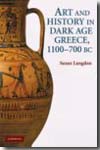Art and identity in dark age greece, 1100-700 B.C.E.
- ISBN: 9780521513210
- Editorial: Cambridge University Press
- Fecha de la edición: 2008
- Lugar de la edición: New York. Estados Unidos de Norteamérica
- Encuadernación: Cartoné
- Medidas: 27 cm
- Nº Pág.: 388
- Idiomas: Inglés

Geometric art is the first coherent style of ancient Greece. It is original, confident. Based on its Greek worldwide appearance and three- century run from 1050 to 700 B.C.E., it must be judged a resounding success. Down to the last half century its aesthetic is immersed in abstraction. Surrounded by virtually nothing but the natural world, painters of pots turn to what is anything but natural: to lines as straight and forms as precise as preindustrial methods can achieve (Fig. 0.1). In the practice there are waverings, miscalculations, sloppiness, omissions, thinnings and thickenings of the slip, even drips. Yet if the potter-painters# aims are measured by the most ambitious productions, the effect is astounding: regularity that approaches the mechanical without releasing its hold on the organic. Unlike their Bronze Age ancestors, these artists created a unified field of figure, object, and ornament. The late appearance of animal and human forms perfectly integrated with their geometric habitat confirms the convictions of the style. There is a willing separation from the direct experience of reality, an inserted barrier composed of the merest millimeter of potter's slip, a slip that holds vast cultural potential. It is a medium for rejecting the world of direct sense and experience in favor of the constructed, the imagined, the interpreted.






